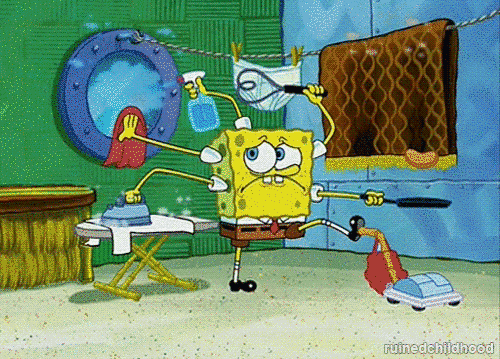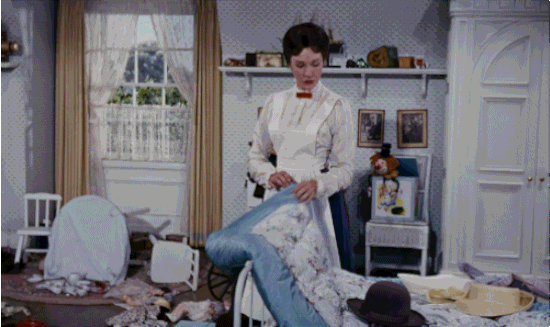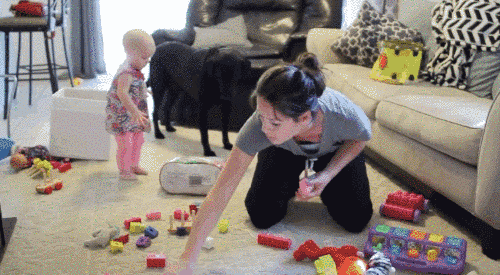Yes, you read that right. I clean my house every day. But it’s not nearly as overwhelming as it sounds. In fact it only takes me twenty minutes or less.
Sounds impossible, right? Wrong! I’m indeed telling the truth and willing to share my secrets so that you too can claim that you clean your house every day.
When I was very early married my new hubby both worked and went to school full-time (like a champion!) while I only worked part-time, so I was the obvious candidate for managing the household chores. I started with the same system I’d grown up with: let all the messes build up over a week and then have one, weekly Clean Everything Day. That was fine as a teenager with only my one bedroom and bathroom to clean, but now I had an entire apartment and twice the mess generated by two people! I suddenly found my Clean Everything Day (Friday) a lot more daunting and time consuming. I began to dread Fridays, and perhaps Thursdays even more because after seven days our apartment grew to embarrassing messiness levels.
I needed an easier solution.
Since I only worked in the mornings (and since I had no kids at that time) I had every virtually every afternoon and evening free. I decided to use some of that free time to pick away at my household cleaning a little bit every day in order to lighten the cleaning load on Friday. That was where this system began and I’ve honed and adapted the process until I’ve mastered it today—five years, two moves, and three babies later.
I call it The Timer Method.
This is How It Works:
I set a timer on my phone for two minutes, just two. Then I clean as much of a single room as I can before the timer goes off. When it beeps I stop cleaning, move to the next room, start the timer again, and clean that room. So on and so forth until I’ve done this for every room in the house. Currently I have nine rooms that I follow this method for, hence how I can clean my entire house in twenty minutes or less, including the few seconds moving from room to room.

Let me clarify a few details:
First, I use the term “clean” a little loosely here. More accurately I should say I “tidy” my home every day. These two-minute tidy-ups don’t include deep scrubbing. Things like mopping, vacuuming, and scrubbing toilets are all separate deep cleaning items for which I follow an entirely different cleaning schedule. But explaining that system is not the purpose of this article today; here and now we’re talking exclusively about the Timer Method.
Second, the Timer Method is easier to maintain if you start with a clean house. Say you’ve cleaned and scrubbed everything for your weekly Clean Everything Day and you’re basking in that peaceful clean-house glow…don’t let it end! Start the Timer Method the very next day and you’ll find it easier to start and keep up with.
That being said, you can use the Timer Method with an initially messy house, but it will take a few days longer before you start to notice a difference or begin to enjoy that peaceful clean-house feeling. But don’t let that discourage you. The Timer Method is supposed to encourage tidying as a daily habit—shoot for long-term progress!
Okay, now you understand the basics, but it probably sounds too good, too easy, to be true, right? I mean, honestly, how much can you really get done in just two measly minutes? Well, quite a bit if you really decide to. Think of it as a race against your timer. Put all other thoughts out of your head and just sweep through the room as fast as you can.
3 Tips Before You Start:
First, if the timer goes off and you haven’t finished tidying that room, remember to STOP and move on. Put away whatever last thing is in your hand and then go to the next room. Prioritize the most important parts of each room and do that very first; other things can wait. This isn’t a deep clean, remember, but a quick tidy.
On the reverse end, if you finish tidying a room before the timer goes off, move immediately to the next room without missing a beat. Rollover that extra time into your next room and use it to your benefit. Specifically bathrooms and the master closet almost never take a whole two minutes to go over, so I use that extra time in the bedrooms, which usually need just a little bit more.
Second, carry a box or basket with you for items that belong elsewhere—I often find that an empty laundry basket is easiest here. When (not if, when) you find items that don’t belong in that room, toss them in the basket and move on. Don’t get bogged down thinking about where that out-of-place item actually belongs or wondering how the heck your kids’ toys ended up in your shower, of all places, but just toss them in your basket and keep cleaning. You’re trying to beat the clock, remember, so don’t get distracted!
Seriously, I can’t be the only one in the world with this problem, can I? I blame my toddlers, mostly, but admittedly I sometimes find my husband’s tools or computer cords in odd places too. But every single day I find toys, socks, wrappers, dishes, books, and all manner of weird things that have crept all over the house. Where does it all come from? Toddlers, that’s where.
As you move from room to room, load and unload your basket as necessary. After you’ve finished every room in the house, spend an extra minute or two putting away anything left in your basket.
Third, prioritize and clean the biggest surfaces first. Think of the very first thing you see when you walk into a room: it’s always the biggest surface such as countertops, tables, and beds. If you have tidy, empty surfaces, it will automatically make the entire room look cleaner.

Okay, you’ve got your timer? You’ve got your basket? Now let’s clean the entire house!
Ready, Set, Go!
To help teach this concept, here’s a specific list of exactly what I do in these two-minute intervals. But remember, I don’t always get this entire list done within those two minutes; after my timer ends, I STOP and move on.
I like to start in the back of my house in the bedrooms and work my way to the main living area and kitchen. This is my house in the order I clean it with my Timer Method:
- Master Closet
- Pick up the floor. Here that’s most likely hangers that have been knocked off, shoes that didn’t quite make it on the shelf, or dirty clothes that missed the hamper. Or, as always, a spare toy or two from my boys’ misadventures. This is usually really fast, like 30 seconds or less, so move immediately to…
- Master Bathroom
- Clean off and wipe counter. Use a wet washcloth and wipe up any spills, toothpaste, hairs, etc. Put washcloth directly in the laundry hamper afterwards.
- Wipe the toilet seat with a disinfecting wipe. This is a quick wipe, not a deep scrub. It’s just so refreshing to sit on a clean toilet seat and not have to wonder what else you might be sitting on, or letting that something else fester for a whole week before Toilet Scrubbing Day.
- Check that the toilet paper is full; restock if necessary. Take out empty toilet paper rolls (they go into my Belongs-Somewhere-Else basket until I reach the recycling box).
- Check that the hand soap is full; refill if necessary.
- Master Bedroom
- Make bed – this is hugely important! Remember to clean the biggest, most noticeable surfaces first; in bedrooms that is the bed. If it’s not made then the rest of the room will NEVER look clean. Especially when you’ve gotten into the habit of making your bed quickly, it only takes a minute or less to pull up the sheets and blankets.
- Pick up the floor.
- Clean off nightstands and dressers.
- Bathroom
- Same as the Master Bathroom: wipe counter, wipe toilet seat, check toilet paper, and check hand soap.
- Check that bath toys are put away in their caddy. I try to clean up bath toys immediately when my boys get out of the bath, but every now and then it doesn’t happen (or my toddlers got in there at some point and tossed the bath toys all around), so a quick glimpse into the tub is helpful.
My Boys’ Bedrooms:
A note on my littles’ bedrooms before I go on. I have three boys aged 3, 2, and 5 months. My two oldest share a room and the baby has the nursery to himself. Yes, I clean their bedrooms for them. Some might argue that they need to learn to clean up their own rooms and toys, and we indeed have other routines and rules in place to teach and encourage them to do just that. However, as my boys are very young I still do a bulk of their cleaning along with fixing their attempts and helping in whatever way they need—they’re only just learning, after all.
A second note: I have a firm rule regarding kids’ stuff: ONLY CLEAN IT ONCE. Even if my boys come immediately behind me and pull out all the books I so neatly put away, I MOVE ON. Otherwise I would drive myself insane following behind them all day every day picking up after them, and that just isn’t what I have planned for my life. So I clean up their things only once a day. After that I walk away, let it be, and pray that things stay in place for as long as possible.

- Bedrooms 1 and 2
- Make beds. Even cribs and toddler beds need to be made! As the largest things in the room, they must look tidy or nothing else will! For cribs I fold and drape the blankets over the crib sides to make things look nice and to get them out of the way for when I lay my little one down.
- Clean off dressers and bookcases.
- Pick up floor, aka toys!
- Put away jammies. Like the bath toys, I try to put their jammies away the moment we get dressed every day, but if by chance we had a busy morning rushing out the door and I just didn’t get to it, I follow up with that now.
- Check that diapers and wipes are stocked; restock if necessary.
- Take out any dirty diapers, asap! (Don’t put these in your elsewhere-basket, because these are worth running out to the trash asap if necessary; make a quick run in between timers.)
- Family Room
- Pick up floor. This usually is fast and easy. Mostly my boys’ toys are stored and limited to their bedrooms or our upstairs toy room (that room isn’t part of this Timer Method and so is cleaned separately). I really try to keep the toys contained to those designated areas; it’s a battle, believe me, but I really think it’s worth it to keep them out of sight. This ideally makes the family room a really quick pick up because usually the only offenders are toys that have leaked out or books that need to go back into the book box. Usually.
- Dining Room
- Clean off and wipe table. Just like beds, the table is the biggest and most noticeable surface in our dining room/kitchen. No matter how clean everything else looks, it always looks messy if the table is cluttered. My goal is to always get the table usable for family dinner there in the evening, even if family dinner isn’t on the schedule that day.
- Pick up floor. This is usually a very small job with the most typical offenders being perhaps shoes that got left by the back door or something like that.
- Kitchen
- First goal: clean off and wipe counters (as the biggest, most-noticeable surface, of course!).
- Second goal: wash and/or put away hand-wash-only dishes.
- Third goal: load or unload the dishwasher.
The kitchen is one room that obviously will never get totally cleaned in two minutes which is why I think of it in terms of “goals” instead of “to do” items. Outside of the Timer Method, I try (“try” being key here) to unload the dishwasher right after breakfast and then load dirty dishes throughout the day. That night, after my boys are in bed, I actually clean the kitchen which includes loading and starting the dishwasher, washing other dishes by hand, and spot-sweeping the floor. That’s a really nice ideal and it doesn’t always happen, but it’s what I strive for.
Regardless, I still put my Two Minute Timer Method to good use in the kitchen by working toward those goals. Just like anywhere else, you’d be surprised at how much you can get done in just two minutes—that’s all it takes to load almost your entire dishwasher, after all. And you’ll be pleased with how much just those two little minutes lightens the rest of your kitchen-cleaning throughout the day.
Done and done. After that last timer goes off I throw down my wash cloth and waltz the heck out of there, head held high in knowing that I’ve cleaned my entire house that day! Hooray for me!

Major Benefits of the Timer Method:
It’s Flexible! Clean More or Clean Less
If my house is particularly messy I set my timer for three or four minutes per room and get more done. I don’t normally do this Timer Method on the weekends, so it’s most often on Mondays that I find myself needing to up the time just a little bit (it’s really shocking how messy things can get in just a day or two!), or if perhaps I’ve skipped a few days of tidying and need to play a little catch-up.
Or if I’m in a big hurry then I’ll do a super speed tidy and only set the timer for one minute, just long enough to fit in the basics—make the beds, pick up the floor, and get the heck out of there!
It Will Teach You to Clean Quickly
Racing the clock and seeing how much I can get done before the timer goes off has retrained my brain to clean quickly. Even when I’m not specifically timing my tidying sessions I’ve learned not to dawdle or procrastinate a chore; I whip through it! Of course I always try to do a quality job, but I find myself focused on the end goal, a clean space, and so I don’t feel bogged down by the chore itself.
Another way this has retrained my brain is that when I’m just passing through my house I find myself naturally putting away little things as I go. I now respond to those small items as, “That will only take five seconds to put back in the drawer,” and so I just do it. Why wait for something so small? This Timer Method has quite literally retrained my brain to look at chores and cleaning in a different, more efficient way.
Start, Stop, or Restart Any Time of Day
Before I started this method if I set to cleaning a room then I didn’t stop until it was done. Interruptions were difficult to handle and it was even harder to restart if I had to step away for something. And anyone with kiddos knows that distractions and interruptions are guaranteed to happen almost constantly!
But the Timer Method is totally different! I can stop after any (or all) two minute intervals if necessary and handle a new distraction. Most obviously, I utilize these little breaks between the timer to check on my boys. This is their independent play time and two minutes is the perfect interval to poke my head into their bedroom, intervene in a toy-sharing crisis, change a diaper, fix a toy, wipe a nose, or get a snack. Then I set my timer again and keep going in the next room.
(A fair note here: at the beginning of this article I said that I can clean my entire house in twenty minutes, but let’s be realistic here: when my boys are having a rough time, that stretches out my breaks between timed sessions, which of course only drags out the entire process. Still, I’d say most regularly I finish the whole thing in half an hour or less, including longer kid-checking breaks.)
Or if something bigger comes up I can stop the Timer Method entirely and pick it up again later in the day without a problem. Typically I like to do my Timer Method first thing after our morning routine; I find that getting it all done quickly gives me a nice sense of accomplishment early on and I can enjoy the rest of the day in a tidy house without my Cleaning To Do list hanging over my head.
But of course life doesn’t always happen so neatly. If we have early appointments or errands sometimes I start my Timer Method but don’t have time to finish before we have to leave. This method is easy enough to start and stop at any time that I can still finish up the family room and kitchen in the afternoon when we get home. No big deal!
It Takes the Load Off Big Cleaning Days
Remember I initially came up with this idea to help lighten those big Clean Everything Days. When it’s time to deep clean a space, I don’t have to waste time tidying up and clearing away that space; it’s already ready to be deep cleaned! When it’s time to vacuum I know that the floor is already picked up so I can just whip out my vacuum and go. When it’s time to scrub the toilet I bask in the happiest knowledge that the yuckiest toilet seat has already been wiped daily and therefore needs less scrubbing.
I also use the Timer Method to analyze each room as I go through it. This also helps on Big Cleaning Days because I don’t have to wander the entire house to check and plan what needs to be done; I’ve already checked the laundry situation daily, restocked various necessities, evaluated how badly the piano needs dusting, and checked for sticky spots on the kitchen floor. That sort of thing.
Never Fear the Spontaneous Visitor
When I was a teenager I loved hosting parties for my friends but I hated and stressed like crazy over the prep. Mostly based on the unrealistic expectations I had for myself and the perfect persona I wanted to portray, I overwhelmed and exhausted myself before every get-together making sure that every square inch of the entire house was spotless…and then I let it all fall apart over the course of the week and let the messes build and build.
Based on that mentality, I was always terrified of unexpected guests. “I’ll be right over” meant that I’d spend five insane minutes throwing as much of my mess into my closet and under my bed as quickly as possible. I was mortified at the thought of my friends seeing the disaster I let my room become in between each Cleaning Day, especially as I’d already set that high bar for myself that no one ever saw my room unless it was spotless—I felt like I had to keep up that spotless (and very inaccurate) image.
Now, after implementing the Timer Method, I no longer fear spontaneous visitors. I’m confident that my house is at least basically tidy, even if it hasn’t been thoroughly scrubbed. Most guests—especially quick ones—won’t notice if the carpets need a good vacuum or if the toilet bowl is forming a ring. However, guests will notice if your biggest surfaces are overflowing with mess, thus why I prioritize those big surfaces always!
The short of it is this: the Timer Method is meant to quickly tidy your house so that the naked, unknowing eye of an unexpected guest can focus on the empty kitchen table and the picked-up floor; they’ll never even notice anything else before they’re out the door again. It’s a really sneaky way to make people think you always have a clean house. You might have overflowing laundry hidden in the closet, sticky spots on the kitchen floor, and shower grungies in the corners, but the appearance of overall tidiness goes a long way to overlook those other issues.
Prioritize What is Most Important: Your Family.
The Timer Method is supposed to free up the rest of your day for what’s most important: your family. The point of this entire thing is to not spend three or four hours a day cleaning your house. Spend only twenty minutes on this and then STOP. No matter the state of the room after your two-minute tidy, leave it there—you’ll get to the rest tomorrow…and the day after that, and the day after that. For now, put the housework out of your mind until the next day.
Seriously.
Read to your kids. Get on the floor and play with them. Sing songs. Take them to the park. Be present with your family and don’t feel guilty for not spending every second cleaning. On the contrary, bask in the glory of being able to announce, “I cleaned my entire house today!” at 11:00am. Give yourself a pat on the back, you good housekeeper you!
Remember, a clean house is a means to an end, not an end in and of itself. Why do I want a clean house? So my family has a safe, peaceful, and usable space to play, be together, and share our lives. If I drive myself and my family absolutely nuts by cleaning too much too often and missing out on spending time with them to do so, then I’ve missed the point entirely. We’re not shooting for spotless perfection here, we’re shooting for those goals: Safe, Peaceful, and Usable.
How To Use the Timer Method Successfully:
Now here’s the biggest kicker to make the Timer Method successful: it’s not a one-time fix, but a long-term habit. The idea is to prevent overwhelming messes from piling up, which can only be done little by little every day. If you pick up the floor every single day then the job will stay little and you can do it in a minute or less. But if you have to pick up a week’s worth of junk all at once, that only takes longer and longer, rendering the Timer Method essentially useless, and it feels more and more exhausting. Keep up the Timer Method as much as possible every day and I promise you’ll see some results. Make it a normal part of your morning routine and then you too can claim that you clean your house every day!
Final Thoughts: Adjusting the Timer Method to Major Life Changes
I originally wrote this article before Baby #3 was born and I only had two little boys. We moved into our new house when I was five months pregnant and my Timer Method moved very easily with us; transferring it from my old house to my new one was easy and worked really well.
Then I had my baby and, well…let’s just say that I’m still relearning how to keep up on my housework with three kiddos to boot. Three somehow feels a lot more overwhelming to me than two did and I’m still getting a hold of my life over here.
So let me be perfectly honest without sugarcoating anything: The Timer Method isn’t ideal with new babies. Remember, the Timer Method is supposed to be fast, a race against the clock, and postpartum mama-bodies are anything but fast, believe me; I was continually frustrated with myself that I simply couldn’t move quickly enough to get everything I normally did during those two little minutes done, with or without Baby in my arms.
My baby is no longer a newborn, but I’m still working back into the Timer Method; after all, my older boys can be okay on their own for two minute intervals, but my baby can’t. So as much as I can, I use the Timer Method when Baby is sleeping or with Daddy (which obviously isn’t first thing in the morning, as he’s at work). Otherwise, I’ve been tidying my house daily with a slower, much more relaxed system. Instead of beating the clock, I focus on cleaning those most noticeable and biggest parts of the most important rooms, but at my own leisurely pace, usually with Baby on my hip. Yes, it takes me significantly longer than twenty minutes to clean my entire house this way, but it’s all a work in progress.
The point is this: be flexible! The Timer Method might not work in all cases, such as with new babies. But work toward this style of system that emphasizes lightening your load, tidying up every single day, and exercising those good habits. I’ll get back into my groove eventually and be fast as ever with my Timer Method one day, just like I did after babies #1 and #2. But don’t beat yourself up if life throws you a curve ball and you need to alter things to better fit your circumstances.





